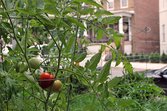Our Tomato Whisperer helps you fight insects and diseases that eat your tomatoes before you get a chance.
By now your tomatoes are in the ground, growing tall, setting fruit, promising a bumper crop of luscious fruit … or not.
Maybe your tomato plants are yellow and wilting, their leaves full of holes, their fruit half-eaten or marred with ugly brown spots. What’s a backyard gardener to do?
Take a deep breath, and let me help you. Here are common tomato problems and their cures (tip: prayer helps).
Blossom End Rot
Symptoms:Large, sunken, leathery brown spot on the bottom (blossom end) of the fruit.
Cause: Calcium deficiency or too little water.
Cure: Apply calcium sulfate (gypsum) or crushed eggshells to the planting hole. Water about 1 inch twice a week if there’s no rain, and top with 2 inches of mulch around plants.
Tomato Spotted Wilt Virus
Symptoms: How can you tell if your garden has this No. 1 tomato disease?
- Young leaves curl, turn yellow or bronze, or develop black spots.
- Black streaks on stems.
- Green fruit has bumps.
- Mature fruit sports yellow or brown ringspots.
Cause: Virus spread by thrips, tiny insects that suck the life out of tomatoes.
Cure: Apply insecticides as soon as symptoms appear. If you don’t want to spread chemicals on your plants, spray them with insecticidal soap or horticultural oil. Remove infected plants and control weeds, where thrips like to lay eggs.
Fusarium Wilt
Symptoms: Leaves and/or branches wilt, turn from yellow to brown, and eventually die; brown discolorations on and within stems.
Cause: Soil-borne fungi that block the plant’s vascular system, preventing water from traveling through the plant.
Cure: Prevention is the only cure, so choose tomato varieties labeled VFN, which are resistant to Verticilum Wilt, Fusarium Wilt, and nematodes (worm-like animals that eat plants). Throw out infected plants, and avoid planting tomatoes in that spot for at least 4 years.
Insect Invasion
Symptoms: Chewed stems, defoliation, holes in leaves, yellowing and curled leaves, and discolored or holey fruit.
Cause: Lots of insects can hurt your tomato plants by either sucking or chewing leaves, stems, and fruit. Here are some prime suspects:
- Thrips
- Aphids
- Tomato cutworms
- Flea beetles
- Psyllids
- White flies
- Stink bugs
- Slugs
Cure: First identify the culprit. If you’re stuck, send a sample of the bug and the plant to your local extension service. Once you know what’s eating your tomatoes, you can control infestation by:
- Plucking (tomato cutworms, slugs).
- Dousing with jet streams of water (aphids, stink bugs).
- Planting a “trap crop,” such as southern giant mustard (flea beetles).
- Attracting beneficial insects, such as lace wings and parasitic wasps (psyllids, white flies).
- Spraying with insecticidal soaps and horticultural oils (thrips).
- Applying insecticides (last resort).
Plants Won’t Set Fruit
Symptoms: Blossoms drop and no fruit appears.
Cause: Tomato plants, which are self-pollinating, refuse to set fruit when their living conditions aren’t just right — too hot, too cold, too moist, too dry. If nighttime temperatures are over 70 degrees or below 50 degrees, or your plants don’t get enough sun, pollination won’t occur and baby tomatoes will not be born.
Cure: There’s not much you can do about temperature, but you can plant tomatoes in spots that get 8 to 10 hours of sun daily. To enhance pollination, gently shake plants, or touch an electric toothbrush to stems: Vibrations will loosen and distribute pollen.
If you’re still hungry for information on growing tomatoes, check out this story: How To Grow The Best Tomatoes Ever.
And if your tomatoes fail to thrive, send us a question — better yet, a picture — in our comments section, and we’ll diagnose the problem and suggest some solutions.




